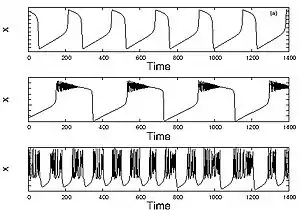
The Rulkov map is a two-dimensional iterated map used to model a biological neuron. It was proposed by Nikolai F. Rulkov in 2001.[1] The use of this map to study neural networks has computational advantages because the map is easier to iterate than a continuous dynamical system. This saves memory and simplifies the computation of large neural networks.
The model
The Rulkov map, with as discrete time, can be represented by the following dynamical equations:
where represents the membrane potential of the neuron. The variable in the model is a slow variable due to a very small value of . Unlike variable , variable does not have explicit biological meaning, though some analogy to gating variables can be drawn.[2] The parameter can be thought of as an external dc current given to the neuron and is a nonlinearity parameter of the map. Different combinations of parameters and give rise to different dynamical states of the neuron like resting, tonic spiking and chaotic bursts. The chaotic bursting is enabled above
Analysis
The dynamics of the Rulkov map can be analyzed by analyzing the dynamics of its one dimensional fast submap. Since the variable evolves very slowly, for moderate amount of time it can be treated as a parameter with constant value in the variable's evolution equation (which we now call as one dimensional fast submap because as compared to , is a fast variable). Depending on the value of , this submap can have either one or three fixed points. One of these fixed points is stable, another is unstable and third may change the stability.[3] As increases, two of these fixed points (stable one and unstable one) merge and disappear by saddle-node bifurcation.
Coupling
Coupling of two neurons has been investigated by Irina Bashkirtseva and Alexander Pisarchik who explored transitions between stationary, periodic, quasiperiodic, and chaotic regimes.[4] They also addresses the additional consequences of random disturbances on this system, leading to noise-induced transitions between periodic and chaotic stochastic oscillations.[5]
Other applications
Adaptations of the Rulkov map have found applications in labor and industrial economics, particularly in the realm of corporate dynamics.[6] The proposed framework leverages synchronization and chaos regularization to account for dynamic transitions among multiple equilibria, incorporate skewness and idiosyncratic elements, and unveil the influence of effort on corporate profitability. The results are substantiated through empirical validation with real-world data.[6] Orlando and Bufalo introduced a deterministic model based on the Rulkov map,[7] effectively modeling volatility fluctuations in corporate yields and spreads, even during distressed periods like COVID-19. Comparing it to the ARIMA-EGARCH model, designed for handling various volatility aspects, both models yield comparable results. Nevertheless, the deterministic nature of the Rulkov map model may provide enhanced explanatory capabilities.[8]
Other applications of the Rulkov map include memristors,[9][10] financial markets,[11][12] biological systems,[13] etc.
See also
References
- ↑ "Modelling of spiking-bursting neural behavior using two dimensional map",
- ↑ Igor Franovic´; Vladimir Miljkovic´ (2011). "The effects of synaptic time delay on motifs of chemically coupled Rulkov model neurons". Commun Nonlinear Sci Numer Simulat. 16 (2): 623–633. Bibcode:2011CNSNS..16..623F. doi:10.1016/j.cnsns.2010.05.007.
{{cite journal}}: CS1 maint: multiple names: authors list (link) - ↑ N.F. Rulkov (2001). "Regularization of Synchronized Chaotic Bursts". Physical Review Letters. 86 (1): 183–186. arXiv:nlin/0011028. Bibcode:2001PhRvL..86..183R. doi:10.1103/physrevlett.86.183. PMID 11136124. S2CID 7016788.
- ↑ pubs.aip.org https://pubs.aip.org/aip/acp/article/2172/1/070004/598377/Variability-and-effect-of-noise-on-the-corporate. Retrieved 2023-10-01.
{{cite web}}: Missing or empty|title=(help) - ↑ pubs.aip.org https://pubs.aip.org/aip/acp/article/2172/1/070004/598377/Variability-and-effect-of-noise-on-the-corporate. Retrieved 2023-10-01.
{{cite web}}: Missing or empty|title=(help) - 1 2 Orlando, Giuseppe (2022-06-01). "Simulating heterogeneous corporate dynamics via the Rulkov map". Structural Change and Economic Dynamics. 61: 32–42. doi:10.1016/j.strueco.2022.02.003. ISSN 0954-349X.
- ↑ Orlando, Giuseppe; Bufalo, Michele (2022-06-01). "Modelling bursts and chaos regularization in credit risk with a deterministic nonlinear model". Finance Research Letters. 47: 102599. doi:10.1016/j.frl.2021.102599. ISSN 1544-6123.
- ↑ Orlando, Giuseppe; Bufalo, Michele (2022-06-01). "Modelling bursts and chaos regularization in credit risk with a deterministic nonlinear model". Finance Research Letters. 47: 102599. doi:10.1016/j.frl.2021.102599. ISSN 1544-6123.
- ↑ Lu, Yanmei; Wang, Chunhua; Deng, Quanli (2022-10-02). "Rulkov neural network coupled with discrete memristors". Network: Computation in Neural Systems. 33 (3–4): 214–232. doi:10.1080/0954898X.2022.2131921. ISSN 0954-898X. S2CID 252736680.
- ↑ Li, Kexin; Bao, Bocheng; Ma, Jun; Chen, Mo; Bao, Han (2022-12-01). "Synchronization transitions in a discrete memristor-coupled bi-neuron model". Chaos, Solitons & Fractals. 165: 112861. Bibcode:2022CSF...16512861L. doi:10.1016/j.chaos.2022.112861. ISSN 0960-0779. S2CID 253704669.
- ↑ Orlando, Giuseppe; Bufalo, Michele; Stoop, Ruedi (2022-02-01). "Financial markets' deterministic aspects modeled by a low-dimensional equation". Scientific Reports. 12 (1): 1693. Bibcode:2022NatSR..12.1693O. doi:10.1038/s41598-022-05765-z. ISSN 2045-2322. PMC 8807815. PMID 35105929.
- ↑ Stoop, Ruedi; Orlando, Giuseppe; Bufalo, Michele; Della Rossa, Fabio (2022-11-18). "Exploiting deterministic features in apparently stochastic data". Scientific Reports. 12 (1): 19843. Bibcode:2022NatSR..1219843S. doi:10.1038/s41598-022-23212-x. hdl:11311/1233353. ISSN 2045-2322. PMID 36400910.
- ↑ Bashkirtseva, Irina; Ryashko, Lev (2023-07-01). "Structural and stochastic transformations in a system of coupled populations". The European Physical Journal Special Topics. 232 (8): 1247–1252. Bibcode:2023EPJST.232.1247I. doi:10.1140/epjs/s11734-022-00762-9. ISSN 1951-6401. S2CID 256042853.